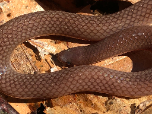Eastern Worm Snake ssp. (Carphophis amoenus amoenus)
Description: A small, slender snake reaching a maximum total length of 13.3 inches. In Virginia, maximum known snout-vent length (SVL) is 10.8 inches and total length is 12.6 inches. Dorsum of body and head unpatterned and plain brown; venter unpatterned but pink, with pink coloration extending onto sides of body to include 1st to 2d scale rows. The head is slightly flattened and somewhat pointed. The short tail terminates in a sharp spine.
Habitat: They are normally found in forests with high leaf litter and canopy cover. They generally remain inactive during extreme temperatures. They burrow by working their small, pointed heads into cracks and crevices.
Range: The species' range extends from southwest Massachusetts, south to southern Alabama, west to Louisiana and north to Illinois.
Diet: Males travel much farther than females and their diets consist primarily of earthworms, but may also include other soft-bodied invertebrates, such as insect larvae.
Reproduction: Courtship and mating probably occur in the spring; the sexes are most often found together between late April and June. Then, the developing eggs can be seen through the translucent venter of the female in late May and June. Oviposition takes place between early June and mid-July. Eggs are laid in late June or early July, two to eight per clutch. The eggs are smooth and elongated, 0.63 to 0.98 inches long by 0.28 to 0.31 inches wide. Often, one end of an egg is wider than the other. Hatching occurs in August or early September. Hatchlings are about 3.9 inches in total length. They are darker than adults. The clutches of eggs are found in depressions under rocks, in cavities in the rotting wood of logs and stumps, and in old sawdust piles; and rodent burrows are probably also used for nesting. A female was nearby or with the eggs in 75% of the cases.
Status: Listed as Least Concern in view of its wide distribution, presumed large population, and because it is unlikely to be declining fast enough to qualify for listing in a more threatened category.
»» Kingdom: Animalia - Animals
»» Phylum: Chordata - Chordates
»» Subphylum: Vertebrata - Vertebrates
»» Class: Reptilia - Reptiles
»» Order: Squamata - Scaled Reptiles
»» Suborder: Serpentes
»» Superfamily: Colubroidea
»» Family: Colubridae - Colubrids
»» Genus: Carphophis
»» Species: Carphophis amoenus - Eastern Worm Snake
»» Subspecies: Carphophis amoenus amoenus - Eastern Worm Snake ssp.
This article uses material from the Wikipedia article "Eastern Worm Snake", which is released under the Creative Commons Attribution-Share-Alike License 3.0. Content may have been omitted from the original, but no content has been changed or extended.
|













